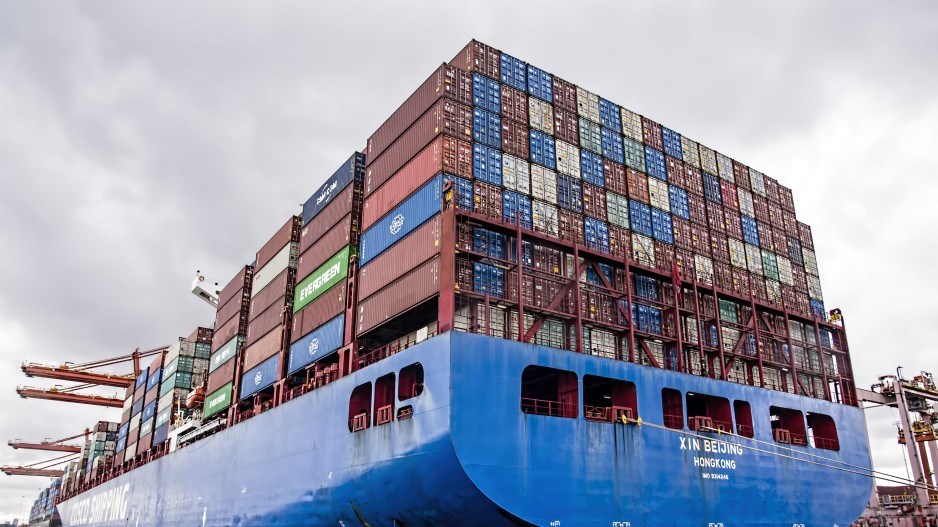Container shipping companies in B.C. and elsewhere in North America face earnings navigation complications in 2023 as the worldwide downturn in the industry continues to deepen.
The steep drop in net income for major shipping lines is consistent with a slowdown in demand on the transpacific and other major trade routes.
Fourth quarter 2022 financial results for the global container shipping fleet compiled by industry analyst John McCown show net income down 33.9 per cent to US$34.7 billion compared with the same quarter in 2021.
Even though Q4 2021 was part of a historic pandemic profit party enjoyed by the world’s major container shipping lines, McCown pointed out that Q4 2022 net income was also down 41 per cent or US$24.2 billion compared with Q3 2022.
According to McCown’s most recent container shipping sector financial results, the decrease “is the second quarterly downturn following seven straight quarters of record net income for the sector driven by significant pricing increases across most container lanes.”
He predicts that the sector’s 2023 net income will hit US$43.2 billion, which would be 79.9 per cent below 2022’s earnings.
Many factors have dimmed the lights at shipping’s pandemic profit party.
They include weaker consumer demand, a looming recession, Russia’s Ukraine invasion, rising U.S.-China geopolitical tensions and increased shipping capacity.
The outlook for the rest of the year is far from bright, and along North America’s West Coast it will be bleaker still if the U.S. and B.C. run off the rails and divert more cargo to ports on North America’s Gulf and East coasts.
Major shipping lines know the pandemic economy numbers are not sustainable.
McCown notes that their unprecedented 2020-22 revenue run leap-frogged the container shipping industry from being near the bottom of overall industry financial performance to the top “if net income as a percent of revenue is used as the yardstick.”
The container shipping industry’s 2022 net income is estimated to be US$215.3 billion. Compare that with the industry’s cumulative loss of US$8.5 billion in the four years prior to the pandemic.
That is a dramatic financial turnaround that will be difficult to duplicate. Major shipping lines agree.
In its Q3 2022 financial report, Hapag-Lloyd Group (ETR:HLAG), Germany’s largest container shipping company, warns of weakening demand that began in 2022’s second half and a downward forecast for global container cargo volume growth in 2022 and 2023.
A.P. Moller-Maersk (CPH:MAERSK-B), the world’s second largest container shipping company, points to demand shrinking between two and four per cent in 2022, and a 2023 global container market that its Q3 2022 financial report forecasts “is expected to be broadly flat to negative; [and], given the current macroeconomic backdrop, risks are skewed to the downside.”
Meanwhile, U.K.-based shipping industry consultancy Drewry estimates that shipping contract rates this year in the transpacific and Asia-Europe trade lanes will be cut between 55 per cent and 85 per cent.
Add this year’s expected capacity expansion of the global container shipping fleet to that down demand outlook.
According to global shipping data company Alphaliner, the world’s 11 largest ocean carrier companies are scheduled to take possession of 89 large container ships this year, 31 of which are megamax vessels that can carry 24,000 20-foot-equivalent units (TEUs).
In total, the fleet’s capacity is expected to be expanded by seven million TEUs in 2023 and 2024. That order book, according to Danish Ship Finance, equals 25 per cent of the fleet, which it notes is a 12-year high.
Vancouver-based Seaspan Corp. has played a major role in that fleet expansion.
The world’s largest independent lessor of container ships has expanded its fleet to 131 ships from zero in 2001. It also has 67 ships under construction and will have a working fleet of 153 ships this year and 189 by the end of 2024. Seaspan’s total carrying capacity will be approximately 1.96 million TEUs when all Seaspan’s newbuilds are delivered.
Its revenue from container ship leasing dropped 1.6 per cent to US$398 million in 2022’s fourth quarter due in part to lower leasing rates resulting from the industry’s demand downturn. But Seaspan’s ship leasing revenue was up 5.7 per cent overall in 2022 to US$1.54 billion compared with 2021.
from a consortium of investors.
Poseidon Acquisition Corp.’s US$10.9 billion deal to acquire Atlas-Seaspan Corp. and take the company private was officially completed on March 28.
Navigating the volatile and competitive waters of the container shipping’s post-pandemic economy as east-west trade and political tensions escalate will be its most pressing challenge over the next two years.




